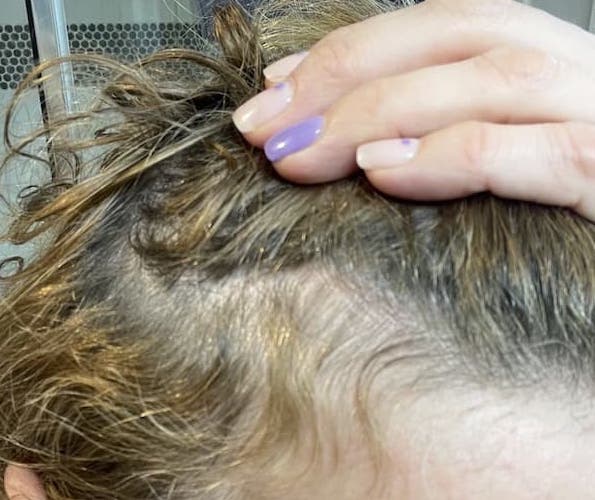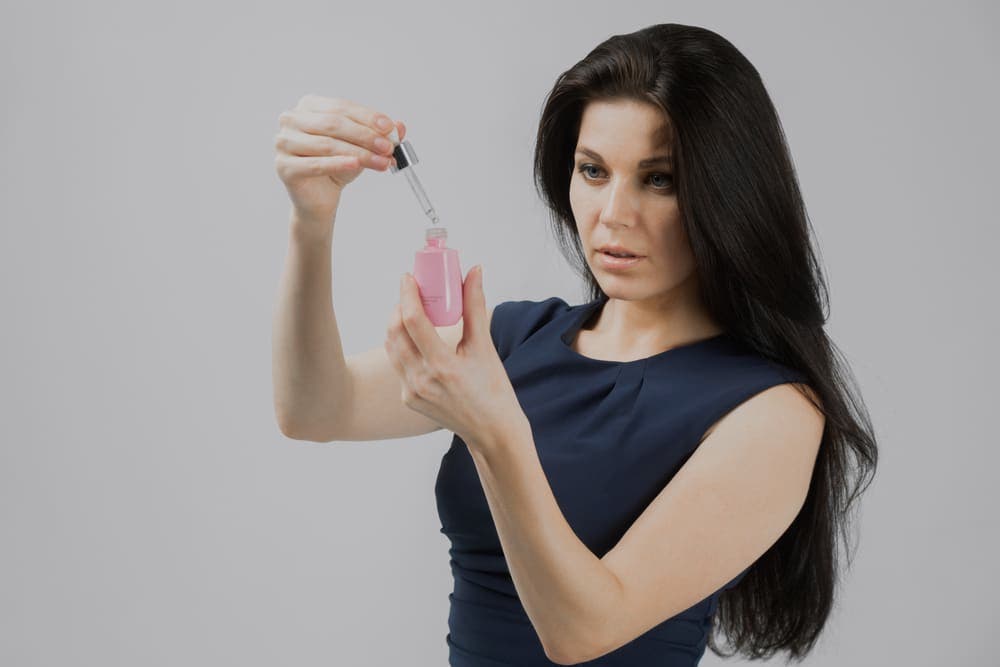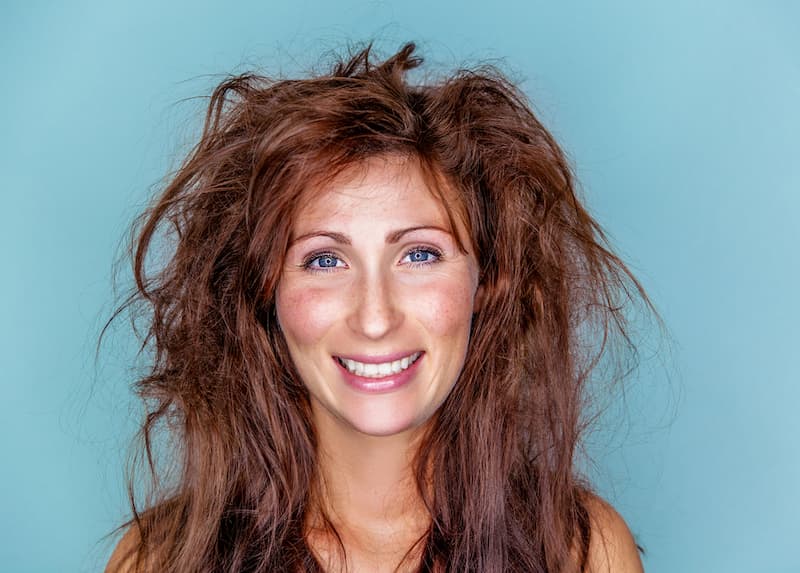
How To Regrow Baby Hairs After Hair Thinning?
Have you ever glanced in the mirror and noticed delicate, baby hairs along your hairline, seemingly out of nowhere?
For many, the appearance of "baby hairs" sparks both intrigue and concern.
While baby hairs are natural and common, it's crucial to recognize when they may indicate a more significant change in our hair's overall health.

I LOVE MY HAIR NOW
FullyVital hair serum and hair vitamins made tremendous improvements in my hair. I truly love my hair now.
Shop Hair ProductsUnderstanding Baby Hairs
What Exactly Are Baby Hairs?
Baby hairs are the short, fine hairs that sit along the perimeter of your hairline.
They're called “baby” primarily because of their fine texture and length, mimicking the gentle hair often found on infants.
Everyone, regardless of age, might have some amount of baby hairs, but it's their sudden increase or prominence that might raise eyebrows.
Baby Hairs: Natural Occurrence or Sign of Something More?
Naturally occurring baby hairs play an aesthetic role, softening the hairline and giving it a delicate frame.
However, if you find a sudden influx of them, especially after noticing hair thinning or shedding, it might make you wonder: are baby hairs a sign of regrowth?
Scientifically speaking, the answer is nuanced. According to research1, the emergence of new baby hairs can indeed indicate hair regrowth after shedding, but this isn't always the case for everyone.
The crucial thing is observing the pattern and understanding its context.
Are Baby Hairs A Sign of Regrowth?
The question of whether baby hairs are a sign of regrowth is complex.
In some instances, the emergence of new baby hairs is indeed the hair's response to recent shedding or thinning1.
These baby hairs can represent a form of regrowth, marking the early stages of the hair cycle.
However, it's crucial to understand that not every strand of baby hair signals regrowth post-shedding.
For some, it might just be their hair's natural pattern or texture. The key is to monitor any changes in response to your haircare routine.
Why Are Baby Hairs Important?
If you want to regrow hair that's been lost due to thinning, its important to follow a specific hair growth routine.
Within a few months of using the correct hair growth routine, you will start to notice tiny baby hairs all over your scalp.
Baby hairs are a signal that your body is regrowing hair.
Baby hairs become big hairs over time.
And big hairs give you a thicker, fuller head of hair and a renewed sense of confidence.
What's The Best Way To Regrow Baby Hairs?
This is a delicate process and requires four steps.
Step 1: Cause a tiny micro-injury to the scalp using a roller.
The tiny injuries caused by a derma roller cause your scalp to send healing and growth factors to your scalp.
The growth factors stimulate and wake up dormant hair follicles, causing them to start growing again.
The growth factors also stimulate new collagen, which supports the regrowth.
In one study, participants noticed 15% new hair growth using just a derma roller alone.
Step 2: Apply A Hair Growth Serum
The roller creates temporary channels in the scalp which allow better absorption of ingredients into your hair follicles.
FullyVital hair growth serum contains powerful actives to help rejuvenate the scalp and regrow new baby hairs.
We recommend using the FullyVital hair serum right after using the derma roller.
The derma roller opens channels in your scalp which allow for improved penetration of the serum.
Step 3: Include Hair Growth Vitamins
Hair growth vitamins support healthy hair growth.
They provide vital nutrients that are required to support thick, healthy hair.
FullyVital hair growth vitamins target all the major reasons for hair thinning: hormone imbalances, stress, thyroid, nutrition, aging and more.
Add the FullyVital hair growth vitamins to your haircare routine to get powerful superfoods and antioxidants to grow luscious hair.
Step 4: Brush Your Hair 200 Times Every Evening
When you brush your scalp vigorously 200 times every evening, it increases circulation to your scalp.
Increased circulation brings oxygen and nutrients required for healthy hair growth.
Brushing also gets rid of dead skin cells and allows your scalp to breathe.
Is It Possible To Regrow Baby Hairs?
It's totally possible to regrow hair that you consider "to be gone".
The most common cause of hair thinning and hair loss is androgenic alopecia (female or male pattern loss).
During this process, the hair strand gets thinner and weaker.
Over a few hair cycles, the hair strand is so thin that it only produces a very small hair that may be invisible to people.
If this condition is not addressed, then over time the follicle may stop producing hair and may be lost for good.
However, it's possible to stimulate the hair follicle to start producing hair again.
This is how you can regrow baby hairs on your scalp. Over time, baby hairs become big hairs.
Final Thoughts: Regrow Baby Hairs After Hair Thinning
Are baby hairs a sign of regrowth? They may be, especially if you are using hair growth products.
The best way to regrow hairs is to use a full system that stimulates hair follicles in 4 different ways to regrow hair.
Use our luscious hair growth bundle to stimulate your hair follicles in four different ways.
This combination is critical to regrow new baby hairs on your scalp.
Keep growing!
Frequently Asked Questions On Baby Hairs
What Does It Mean If You Have Baby Hairs?
"Baby hairs" refer to the fine, wispy hairs located at the forefront of the hairline. Everyone possesses them to some degree, regardless of age or gender.
Their presence can be due to multiple reasons. For some, baby hairs are simply a genetic or natural part of their hair's pattern and texture.
They provide a softer frame to the face and can give a youthful appearance.
However, for others, a sudden or noticeable increase in baby hairs might be indicative of hair regrowth, especially if it follows a period of noticeable hair shedding or thinning.
In such cases, these fine strands can signal that the hair follicles are entering a new growth phase.
On the other hand, certain hair care habits, like frequently wearing tight hairstyles, can break hair and result in shorter strands resembling baby hairs.
Monitoring any sudden changes and consulting a dermatologist can provide clarity on their specific meaning.
Is It Healthy To Have Baby Hairs?
Baby hairs are the short, wispy strands that naturally appear along one's hairline. Having them is entirely normal and, in many cases, a genetic trait.
They can add a soft, youthful frame to the face. For many, these delicate hairs have always been present, remaining consistent throughout their lives.
In instances where there's a noticeable increase in baby hairs, especially after a period of hair loss or thinning, they might signify hair regrowth.
This can be seen as a positive indication that the hair follicles are active and undergoing a new growth phase.
However, if these hairs result from hair breakage due to tight hairstyles or excessive heat styling, it might be a sign of hair stress or damage.
In such cases, reviewing and adjusting hair care practices is advisable. Overall, having baby hairs is typically healthy and natural, but sudden changes should be observed with awareness and understanding.
Do Baby Hairs Ever Grow Out?
Yes, baby hairs can grow out.
While these fine, wispy hairs at the hairline often remain shorter than the rest of one's mane due to their natural growth cycle and potential breakage, they can, under certain conditions, grow longer.
Factors influencing their length include genetics, hair care practices, and overall scalp health. If baby hairs are the result of hair regrowth after shedding, they might eventually grow to match the length of surrounding hair.
Proper care, including gentle handling and avoiding excessive heat or tension on the hairline, can support the growth of these delicate strands.
Can Baby Hairs Turn Into Normal Hairs?
Yes, baby hairs can turn into normal hairs. Baby hairs are typically short and fine, but they originate from hair follicles, just like any other hair on the scalp.
When these hairs are a result of regrowth after shedding or hair thinning, they have the potential to grow thicker and longer, eventually resembling the rest of the hair.
Factors like genetics, hair care routines, and overall scalp health play a role in determining the growth and texture of these hairs.
Proper care and maintaining a healthy scalp environment can support the transition of baby hairs to normal, mature hairs.
References
-
Mirmirani, P. (2013). Age-related hair changes in men: Mechanisms and management of alopecia and graying. Maturitas, 75(1), 9-13. ↩ ↩2
-
Whiting, D. A. (2003). Diagnostic and predictive value of horizontal sections of scalp biopsy specimens in male pattern androgenetic alopecia. Journal of the American Academy of Dermatology, 48(5), S59-S66. ↩
-
Peters, E. M. J., Arck, P. C., & Paus, R. (2006). Hair growth inhibition by psychoemotional stress: a mouse model for neural mechanisms in hair growth control. Experimental Dermatology, 15(1), 1-13. ↩
-
Tosti, A., Piraccini, B. M., & Pazzaglia, M. (2007). Drug reactions affecting hair: diagnosis. Dermatologic Clinics, 25(2), 223-231. ↩
-
Ellis, J. A., Stebbing, M., & Harrap, S. B. (2001). Genetic analysis of male pattern baldness and the 5α-reductase genes. The Journal of Investigative Dermatology, 116(3), 452-457. ↩










